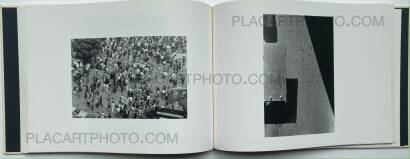CHILDHOOD

Osamu Wataya
CHILDHOOD
Photographs: Osamu Wataya
Publisher: Rat Hole Gallery
216 pages
Year: 2010
Price: 50 €
Comments: Hardcover, 21, 7 x 30,3 cm, b&white and color photographs. cover is soiled otherwise in very good condition.
The four sections that comprise this book are seemingly unrelated- without any ties by place, time, or subject. Nonetheless, they allow the viewer to realize that each photograph subtly and intricately resonates against one another. Since a certain point in time, Osamu Wataya has resigned from pursuing the singularity and purity of photography, and instead has directly acknowledged the idea that immaturity and lightness, as well as humor and nostalgia, are important factors for photography. Each and every photograph resonates in harmony with the other images, filling the world with a myriad of tones. Perhaps it is those tones that represent “oneself” at the same time as representing the world.
“CHILDHOOD” shows no trace of the notion of “me-photography-the world” firmly rooted in the linear thinking of Modernism in photography. However, in the process of creating this book, Wataya’s sixth one, he was most likely faced with frustration towards the overpowering curse that the school of thought bears. Throughout his career, Wataya has explored photography through the eyes of an editor in addition to being a talented photographer himself. Both roles have required him to critically confront Modernism in Japanese post-war photography as well as publish numerous books of photographers who have struggled to overcome it. Through his work with these photographers, it is without a doubt that Wataya fully experienced just how deeply rooted and entrenched Modernism is. This however, most likely reached a limit within himself.
Most of the photographs in this book, from the “Amsterdam” series taken at the beginning of Wataya’s career to his most recent ones in the “Capability” series, have never been presented before. According to Wataya, this was simply a result of reviewing all of his works, regardless of whether they had been seen before or not. There is no attempt here by Wataya to convey an autobiographical narrative that describes his career as a photographer, nor is there a problem consciousness related to contemporary theory. There is no way for us to tell what kinds of emotions were evoked within the artist. However, what remains certain is that “CHILDHOOD” is not a simple retrospective of the past but a perpetual aspiration to encounter an unknown past that extends far beyond.
Like death, childhood is something that lies external to our experiences. Nevertheless, when looking at Wataya’s photographs, one can experience an overflowing consciousness that doesn’t hold any memories of childhood. Wataya’s vulnerable senses capture images of donkeys and the canals of Amsterdam, a little house by the Sea of Okhotsk, glaciers, a Ukrainian boy and cat, a man who is peering at a woman’s hips, foreign lands and hometowns, and the past and present, all of which subtly reverberate against one another and come together for just this one time.



















more books by Osamu Wataya
-
Engaru
by Osamu Wataya
sold -
Love story (numbered edt /300)
by Osamu Wataya
Euro 180 -
Juvenile
by Osamu Wataya
sold -
Icon
by Osamu Wataya
Euro 50 -
Agenda 2001
by Osamu Wataya
Euro 45
more books tagged »rat hole gallery« | >> see all
-
Kirishin (SIGNED)
by Nobuyoshi Araki
Euro 120 -
The Joy of Portraits (Signed)
by Keizo Kitajima
Euro 300 -
Café Lehmitz (Special edition with print)
by Anders Petersen
sold
more books tagged »japanese« | >> see all
-
Yodaka
by Toshio Shibata
Euro 120 -
A.M.S. (signed copy)
by Collective
sold -
Utatane
by Rinko Kawauchi
sold -
Void Tokyo vol.4
by Collective
sold -
SPEW
by Collective
sold -
Akai Kutsu Vol.2
by Daido Moriyama
sold
more books tagged »children« | >> see all
-
Satchin (WITH OBI)
by Nobuyoshi Araki
sold -
Die kleinen Banditen von Bogota
by Collective
Euro 60 -
Lukten av thinner (The smell of thinner)
by Halil
sold -
Wild Grass
by JT
Euro 60 -
Esther Kroon 1966-1992
by Esther Kroon
sold -
SHUN TAK PEOPLE 順德人 (SIGNED)
by Chan Wai Kwong
Euro 58
Books from the Virtual Bookshelf josefchladek.com



























 Facebook
Facebook Instagram
Instagram